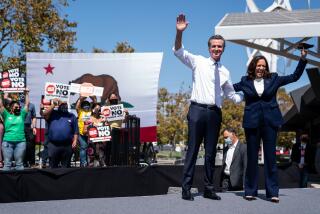California’s right is left aside
- Share via
From Sacramento — There seemed something off kilter about negotiations that led to Gov. Jerry Brown’s revised tax plan to “soak the rich.”
Here was a Democratic governor not negotiating with Republicans the way our two-party system is supposed to function. It was not a negotiation between left and right, but rather between left and far left.
That was one thought I had after Brown and the California Federation of Teachers announced they had compromised and merged their proposed ballot measures to raise taxes. More later about other thoughts.
First about the opposing ideologies in the negotiating mix — left-of-center versus extreme left.
That unfortunately is symptomatic of California’s current political dynamic.
A Democratic governor — basically a moderate — doesn’t find it worthwhile to dicker with conservatives. Brown futilely tried for several months last year to reach a deal with Republican lawmakers in which they’d provide the necessary two-thirds legislative vote to place a tax measure on the state ballot.
Republican leaders wouldn’t negotiate at all. A handful of unranked GOP senators agreed to talk. But for whatever reason — Brown wouldn’t cross labor, Republicans feared anti-tax demagogues — bargaining broke down.
So Brown went the signature-collecting initiative route. To achieve his goal of placing a potentially winnable tax increase on the ballot, the governor felt compelled to deal with the far left. The right — the GOP — was irrelevant.
That’s unhealthy in a democracy. And it’s nobody’s fault except the hard-right GOP’s. The party allowed itself to become so weak in California that it has little to offer Democrats in bargaining. And what it does have, it refuses to offer.
So public policy steers left. The proposed tax hike becomes more liberal.
But wait! Let’s see how Californians vote in November.
If they vote against the tax increase, it would mean — again — that Californians side with the GOP on fiscal issues. And then we’d need to ask why they’re refusing to elect more Republicans to state office.
Mainly it’s because Republican candidates are too scary, especially to independents and women on social issues and Latinos on immigration.
But we’re getting ahead of ourselves.
Some more observations on the tax deal:
• Although Brown caved to libs and agreed to sock the rich more than he had wanted, he insisted on keeping intact the most important element of his original plan: The bulk of the increased revenue would be used to help balance the state budget, not to launch new spending programs.
Exact figures weren’t available, but probably about 65% of the $9 billion immediately generated would be applied to budget-balancing, the rest to schools.
The CFT’s original initiative would have helped schools but done nothing to plug the deficit hole. And a rival tax-everybody measure by wealthy civil rights attorney Molly Munger would pour money into schools but do little for the deficit.
Unless the Brown-CFT compromise is passed by voters, says Senate leader Darrell Steinberg (D-Sacramento), “we’ll be dealing with budget hell for many more years to come. This provides an opportunity to make this the last year of deficits.”
The agreement represented a big victory for a little union. At least the CFT is small compared to the much larger California Teachers Assn., which had been backing Brown’s original plan.
Whoever thought the CFT could roll a California governor? Virtually no one outside the CFT.
“We were the little engine that could,” says CFT President Joshua Pechthalt. “We were committed to something and fighting for it.”
The union — allied with a liberal activist group, the Courage Campaign — was on a crusade not only to raise money for schools but also to force million-dollar income earners to “pay their fair share.”
Brown finally concluded the CFT wouldn’t drop its measure unless he adopted some of its more liberal features. If both were on the ballot, confused voters were likely to kill both.
The CFT stared down Brown and he blinked.
The governor compromised by agreeing to raise income taxes on the rich higher — and for a longer time — than he had desired. And he cut his proposed sales tax hike in half, from half a cent to a quarter of a cent.
“I think, actually, this could have been done months ago,” says Pechthalt, who asserts that until very recently, the governor “hadn’t engaged us in a serious way.
“He came over to my house, but any discussion of working together, it was like, ‘No, can’t do that.’”
It was impatient Democratic legislative leaders — much maligned these days as dysfunctional — who finally led the way in the deal-making.
They weren’t happy anyway with Brown’s sales tax hike, preferring to whack the wealthy harder. Never mind that this would make California’s tax system even more unstable by over-relying on the roller-coaster fortunes of the rich.
The increasing concern of Steinberg and Assembly Speaker John Pérez (D-Los Angeles), however, was that the Brown and CFT initiatives were headed toward a fatal collision.
Democrats are desperate for additional tax revenue to avoid making more sharp cuts in schools, universities and the safety net.
They became particularly alarmed when Pechthalt met privately with Democratic lawmakers on March 8 and vowed to fight all the way to November.
“They could see we weren’t a bunch of crazies,” Pechthalt says. “We weren’t going away. The governor needed to actively engage us.”
The legislative leaders quickly engaged with Pechthalt. The governor joined in over that weekend. Steinberg sketched out a possible deal on that Sunday. By last Tuesday night, they had an agreement.
The left negotiated solely with the left. That’s not right. But it’s all that seems to work in California.
More to Read
Sign up for Essential California
The most important California stories and recommendations in your inbox every morning.
You may occasionally receive promotional content from the Los Angeles Times.














